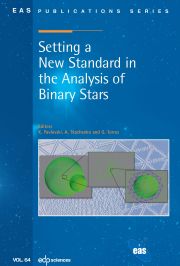No CrossRef data available.
Article contents
Estimating Gaia's performance for O stars in the Outer Galactic plane using Herschel data
Published online by Cambridge University Press: 17 July 2015
Abstract
It is in the less dense Outer Galaxy where Gaia can contribute much to stellar studies of the Galactic Plane. As O stars are by definition young objects, their positions and kinematics can still be related to their formation site and history. O star astrometry will not only be important for studies of high-mass star formation, such as triggered star-formation in shells, but also an interesting complement to the radio maser astrometry of star-forming regions and the structure of spiral arms. With the TLUSTY (Lanz & Hubeny 2013) model atmospheres and the nominal Gaia parallax uncertainty, we estimate the parallax uncertainty for all subtypes of main sequence O stars given a visual extinction. The expected extinction is an important limitation for Gaia's astrometric performance and we estimate the extinction from the column density maps calculated from the Herschel Infrared Galactic Plane survey (Molinari et al. 2010), a thermal cold dust emission survey of unprecedented angular resolution and sensitivity. In the 10∘ strip, taken to represent the first estimate of the average extinction in the Outer Galaxy, we find that most of the visual extinction is less than 10 mag. Only the most dense parts of the clouds have AV > 10 mag. Given these extinctions toward the Outer Galaxy, Gaia will provide accurate (5σ) astrometry for O stars in the Outer Galaxy up to distances of at least 4–6 kpc, which means that Gaia's O star astrometry will be able to transgress the Perseus arm and reach the less-known Outer Arm of the Milky Way (Rygl et al.https://gaia.ub.edu/Twiki/pub/GREATITNFC/ProgramFinalconference/Poster_Rygl%2cK.pdf).
- Type
- Research Article
- Information
- Copyright
- © EAS, EDP Sciences, 2015


